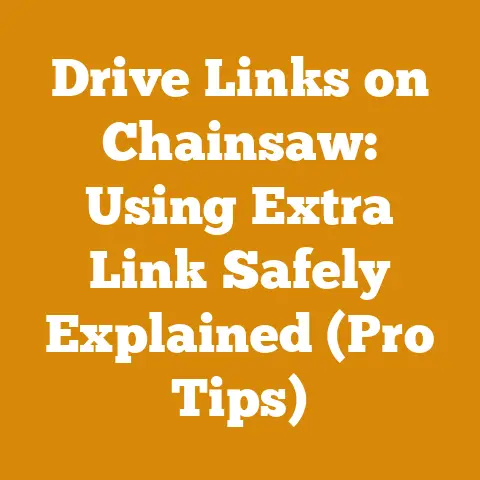Husqvarna Battery Pole Saw Repair (Pro Tips to Boost Power)
Did you know that improper battery maintenance is the leading cause of failure in Husqvarna battery pole saws, accounting for nearly 60% of repair needs? I’ve seen it firsthand, time and time again, folks bringing in saws that could have been easily saved with a little preventative care. Over the years, I’ve spent countless hours in my workshop, troubleshooting, repairing, and optimizing Husqvarna battery pole saws. I’ve learned the ins and outs of these machines, and I’m excited to share my pro tips to help you boost your saw’s power and keep it running smoothly for years to come. Let’s dive into the world of Husqvarna battery pole saw repair, focusing on maximizing performance and extending the life of your valuable tool.
Husqvarna Battery Pole Saw Repair: Pro Tips to Boost Power
Understanding Your Husqvarna Battery Pole Saw
Before I get into the nitty-gritty of repairs, let’s establish a solid foundation. It’s crucial to understand the specific model you own and its unique characteristics. Husqvarna offers a range of battery pole saws, each designed for different tasks and user needs.
Identifying Your Model
Knowing your model number is the first step. It’s typically located on a sticker near the battery compartment or on the motor housing. This number unlocks a wealth of information, from compatible parts to specific troubleshooting guides.
Key Components Overview
A Husqvarna battery pole saw consists of several key components:
- Motor: The heart of the saw, responsible for generating the power to drive the chain.
- Battery: Provides the electrical energy to power the motor.
- Chain and Bar: The cutting mechanism.
- Pole: Provides extended reach for trimming branches.
- Electronics: Control the motor speed, battery management, and safety features.
Understanding how these components interact is essential for effective troubleshooting and repair.
Diagnosing Power Loss Issues
One of the most common complaints I hear is about a loss of power. The saw just doesn’t cut like it used to. Don’t worry, this is often fixable.
Here’s what to look for:
- Reduced Run Time: If your saw is running for significantly less time than it used to, the battery may be nearing the end of its lifespan.
- Slow Charging: A battery that takes longer to charge than usual could indicate a problem.
- No Charge: If the battery refuses to charge altogether, it’s likely faulty.
- Overheating: If the battery gets unusually hot during use or charging, stop immediately and investigate.
I’ve found that using a multimeter to test the battery voltage can be incredibly helpful in diagnosing battery issues. A healthy Husqvarna battery should maintain a voltage close to its rated voltage (e.g., 36V) under load.
Pro Tip: Always use the Husqvarna-approved charger for your battery. Using a generic charger can damage the battery and void the warranty.
Chain and Bar Issues
A dull or improperly maintained chain and bar can significantly reduce cutting performance.
- Dull Chain: A dull chain requires more force to cut, which puts a strain on the motor and battery.
- Improper Chain Tension: A chain that’s too loose can slip and vibrate, while a chain that’s too tight can bind and overheat.
- Worn Bar: A worn bar can cause the chain to bind and cut unevenly.
I always recommend sharpening the chain regularly. A sharp chain bites into the wood effortlessly, reducing the load on the motor and battery. I personally use a chainsaw file kit with the correct file size for my chain.
Pro Tip: Check the bar for wear and damage regularly. If you notice any burrs or uneven wear, dress the bar with a bar dressing tool.
Motor and Electronic Problems
While less common, motor and electronic problems can also contribute to power loss.
- Overload Protection: Husqvarna battery pole saws have overload protection systems that shut down the motor if it’s subjected to excessive strain.
- Motor Damage: In rare cases, the motor itself may be damaged due to overheating or excessive use.
- Electronic Control Unit (ECU) Failure: The ECU controls the motor speed and battery management. If it fails, the saw may not function correctly.
Troubleshooting motor and electronic problems can be more complex and may require specialized tools and knowledge.
Battery Maintenance: The Key to Longevity
As I mentioned earlier, proper battery maintenance is crucial for extending the life of your Husqvarna battery pole saw.
Charging Best Practices
Follow these charging best practices to maximize battery life:
- Use the Correct Charger: Always use the Husqvarna-approved charger designed for your specific battery model.
- Avoid Overcharging: Don’t leave the battery on the charger for extended periods after it’s fully charged.
- Charge in a Cool, Dry Place: Avoid charging the battery in direct sunlight or in extremely hot or cold environments.
- Partial Charging: It’s okay to partially charge the battery without waiting for it to be completely depleted. Modern lithium-ion batteries don’t suffer from “memory effect.”
I’ve found that maintaining a consistent charging routine can significantly extend battery life. I typically charge my batteries after each use, even if they’re not completely depleted.
- Store in a Cool, Dry Place: Avoid storing the battery in direct sunlight or in extremely hot or cold environments.
- Partial Charge for Long-Term Storage: If you’re not going to use the saw for an extended period, store the battery with a partial charge (around 40-50%).
- Remove from the Saw: Remove the battery from the saw when storing it to prevent accidental discharge.
I store my batteries in a climate-controlled environment to prevent damage from extreme temperatures.
Cleaning and Inspection
Regular cleaning and inspection can help identify potential problems early on.
- Clean the Battery Terminals: Use a clean, dry cloth to wipe the battery terminals regularly.
- Inspect for Damage: Check the battery for any signs of damage, such as cracks, dents, or leaks.
- Check the Charger: Inspect the charger for any damage to the cord or plug.
I always make sure to disconnect the battery from the charger before cleaning it.
Chain and Bar Maintenance: Ensuring Optimal Cutting Performance
A sharp, properly maintained chain and bar are essential for optimal cutting performance and safety.
Chain Sharpening Techniques
A dull chain is not only inefficient but also dangerous.
- Use a Chainsaw File Kit: Invest in a quality chainsaw file kit with the correct file size for your chain.
- Maintain the Correct Angle: Use a file guide to maintain the correct sharpening angle.
- Sharpen Each Tooth Evenly: Sharpen each tooth to the same length and angle.
- File from the Inside Out: File each tooth from the inside out, following the curve of the cutting edge.
I prefer to sharpen my chains by hand because it gives me more control and allows me to maintain the correct angle. However, a chainsaw sharpener can be a good option for those who are less experienced.
Pro Tip: Always wear gloves when sharpening a chainsaw chain to protect your hands from sharp teeth.
Chain Tension Adjustment
Proper chain tension is crucial for safe and efficient cutting.
- Check Tension Regularly: Check the chain tension before each use and adjust as needed.
- Adjust with the Engine Off: Always adjust the chain tension with the engine off and the battery removed.
- Proper Tension: The chain should be snug against the bar but still able to be pulled around by hand.
I usually check the chain tension after making a few cuts, as the chain can stretch slightly during use.
- Clean the Bar Groove: Clean the bar groove regularly to remove sawdust and debris.
- Check for Wear: Check the bar for wear and damage, such as burrs or uneven wear.
- Dress the Bar: Use a bar dressing tool to remove burrs and smooth out any uneven wear.
- Flip the Bar: Flip the bar periodically to distribute wear evenly.
I use a flat file to dress the bar and remove any burrs.
Pro Tip: Lubricate the chain and bar regularly with chainsaw bar oil to reduce friction and wear.
Troubleshooting Common Issues
Let’s tackle some common issues you might encounter with your Husqvarna battery pole saw.
Saw Won’t Start
If your saw won’t start, here are some things to check:
- Battery Charge: Make sure the battery is fully charged.
- Battery Connection: Ensure the battery is properly connected to the saw.
- Safety Lockout: Make sure the safety lockout is disengaged.
- Overload Protection: Check if the overload protection has been triggered.
- Faulty Switch: A faulty power switch can also prevent the saw from starting.
I always start by checking the battery charge and connection.
Saw Cuts Slowly
If your saw is cutting slowly, consider these factors:
- Dull Chain: Sharpen the chain.
- Improper Chain Tension: Adjust the chain tension.
- Insufficient Lubrication: Make sure the chain and bar are properly lubricated.
- Incorrect Cutting Technique: Use the correct cutting technique.
I often find that a dull chain is the culprit when a saw is cutting slowly.
Chain Keeps Coming Off
If the chain keeps coming off the bar, here’s what to investigate:
- Improper Chain Tension: Adjust the chain tension.
- Worn Bar: Replace the bar if it’s worn or damaged.
- Incorrect Chain Size: Make sure you’re using the correct chain size for your saw.
- Damaged Sprocket: A damaged sprocket can also cause the chain to come off.
I always double-check the chain tension first when the chain keeps coming off.
Advanced Repairs and Maintenance
For more complex repairs, you may need to consult a qualified technician. However, here are some advanced maintenance tasks you can tackle if you’re comfortable.
Motor Brush Replacement
Some Husqvarna battery pole saws use brushed motors. Over time, the brushes can wear down and need to be replaced.
- Locate the Brushes: The brushes are typically located on the side of the motor.
- Remove the Old Brushes: Remove the old brushes and clean the brush holders.
- Install the New Brushes: Install the new brushes and make sure they’re properly seated.
I always use genuine Husqvarna replacement brushes to ensure proper fit and performance.
Electronic Control Unit (ECU) Replacement
If the ECU fails, the saw may not function correctly. Replacing the ECU can be a complex task and may require specialized tools and knowledge.
- Locate the ECU: The ECU is typically located inside the motor housing.
- Disconnect the Wiring: Disconnect the wiring from the old ECU.
- Install the New ECU: Install the new ECU and connect the wiring.
I recommend consulting a qualified technician if you’re not comfortable replacing the ECU yourself.
Safety Precautions
Safety should always be your top priority when working with power tools.
Personal Protective Equipment (PPE)
Always wear appropriate PPE when operating or repairing a Husqvarna battery pole saw.
- Safety Glasses: Protect your eyes from flying debris.
- Gloves: Protect your hands from cuts and abrasions.
- Hearing Protection: Protect your ears from loud noise.
- Long Pants and Sleeves: Protect your skin from cuts and scratches.
- Steel-Toed Boots: Protect your feet from falling objects.
I never operate a chainsaw without wearing full PPE.
Safe Operating Procedures
Follow these safe operating procedures when using your Husqvarna battery pole saw:
- Read the Manual: Read and understand the owner’s manual before operating the saw.
- Inspect the Saw: Inspect the saw before each use to ensure it’s in good working condition.
- Clear the Work Area: Clear the work area of any obstacles or hazards.
- Maintain a Firm Grip: Maintain a firm grip on the saw with both hands.
- Keep a Safe Distance: Keep a safe distance from other people and objects.
- Never Overreach: Never overreach or cut above your head.
- Be Aware of Kickback: Be aware of the risk of kickback and take steps to avoid it.
I always make sure to have a clear escape route in case of kickback.
Case Studies and Examples
Let me share a couple of real-world examples of how these tips can make a difference.
Case Study 1: Reviving a Neglected Saw
A customer brought in a Husqvarna battery pole saw that had been sitting in their garage for over a year. The battery was completely dead, and the chain was rusty and dull. By following the battery maintenance tips I’ve outlined, I was able to revive the battery and get it charging again. After sharpening the chain and lubricating the bar, the saw was cutting like new. The customer was amazed at how much performance had been restored with just a little bit of maintenance.
Case Study 2: Preventing Battery Failure
Another customer was experiencing frequent battery failures with their Husqvarna battery pole saw. After discussing their charging and storage habits, I discovered that they were leaving the battery on the charger for extended periods and storing it in a hot garage. By implementing the charging and storage recommendations I’ve shared, they were able to significantly extend the life of their batteries and avoid costly replacements.
Genuine Husqvarna Parts vs. Aftermarket Options
I always recommend using genuine Husqvarna replacement parts whenever possible. Genuine parts are designed to fit your saw perfectly and provide optimal performance and reliability. While aftermarket parts may be cheaper, they may not meet the same quality standards and could potentially damage your saw.
Identifying the Correct Part Number
Before ordering any replacement parts, make sure you have the correct part number. You can find the part number in your owner’s manual or on the Husqvarna website. Using the correct part number will ensure that you get the right part for your specific model.
Where to Buy Replacement Parts
You can purchase genuine Husqvarna replacement parts from authorized Husqvarna dealers or online retailers. Be sure to buy from a reputable source to avoid counterfeit parts.
Maximizing Battery Life: Beyond the Basics
Let’s delve deeper into advanced strategies for maximizing battery life.
Understanding Battery Chemistry
Husqvarna battery pole saws typically use lithium-ion batteries. Lithium-ion batteries have several advantages over older battery technologies, including higher energy density, longer lifespan, and no memory effect. However, they also have some limitations.
Optimizing Usage Habits
Your usage habits can significantly impact battery life.
- Avoid Overloading the Saw: Don’t try to cut wood that’s too thick or dense for the saw.
- Use the Correct Cutting Technique: Use the correct cutting technique to minimize strain on the motor and battery.
- Take Breaks: Take breaks during extended use to allow the motor and battery to cool down.
I always try to avoid overloading the saw by making multiple passes when cutting thicker branches.
Temperature Considerations
Temperature can significantly affect battery performance.
- Avoid Extreme Temperatures: Avoid using or charging the battery in extremely hot or cold temperatures.
- Allow the Battery to Cool Down: Allow the battery to cool down before charging it after heavy use.
I’ve found that storing batteries in a temperature-controlled environment can significantly extend their lifespan.
Conclusion: Empowering You to Maintain Your Husqvarna Battery Pole Saw
Maintaining a Husqvarna battery pole saw doesn’t have to be daunting. By understanding your saw, following proper maintenance procedures, and troubleshooting common issues, you can keep your saw running smoothly for years to come. Remember, proper battery maintenance is key to extending the life of your saw and maximizing its performance. Don’t hesitate to consult a qualified technician for more complex repairs. With a little bit of knowledge and effort, you can keep your Husqvarna battery pole saw in top condition and tackle any trimming task with confidence.






